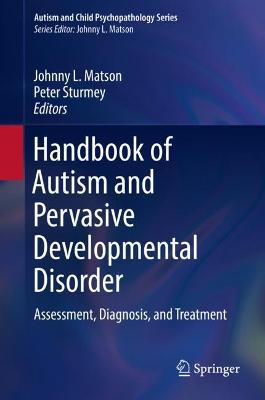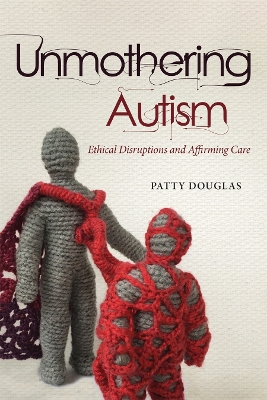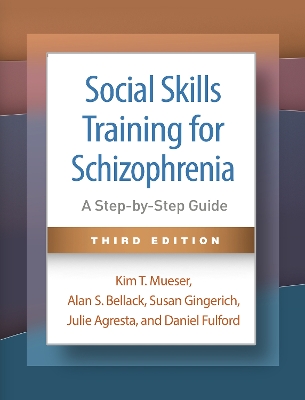Handbook of Autism and Pervasive Developmental Disorder
 portes grátis
portes grátis
Handbook of Autism and Pervasive Developmental Disorder
Assessment, Diagnosis, and Treatment
Sturmey, Peter; Matson, Johnny L.
Springer Nature Switzerland AG
10/2022
1609
Dura
Inglês
9783030885373
15 a 20 dias
Descrição não disponível.
Section 1. And Introduction and Overview to Autism Spectrum Disorder and Pervasive Developmental Disorder.- Chapter 1. History of Autism Spectrum Disorder and Pervasive Developmental Disorder.- Chapter 2. Psychopathologies Associated with ASD and Pervasive Developmental Disorder.- Chapter 3. Challenging Behaviors Associated with Autism and Pervasive Developmental Disorder.- Chapter 4. Sensory Processing and Motor Issues in Individuals with ASD and Pervasive Developmental Disorder.- Chapter 5. Emotional Cognition, Theory of Mind, and Face Recognition in Individuals with Autism and PDD.- Chapter 6. Neurotechnology and Neuroimaging Devices for Assessing Autism and PDD.- Chapter 7. Risk Factors in Autism and Pervasive Developmental Disorder.- Chapter 8. Etiology of Autism and Pervasive Developmental Disorder.- Chapter 9. Epidemiology and Prevalence of Autism and Pervasive Developmental Disorder.- Chapter 10. Quality of Life for Individuals with Autism and Pervasive Developmental Disorder- Chapter 11. Family Adaptations for Individuals with Autism and Pervasive Developmental Disorder.- Chapter 12. Service Models for Autism and Pervasive Developmental Disorder.- Section 2. General Assessment Issues in Autism and Pervasive Developmental Disorder.- Chapter 13. Psychometric Principles and Standards for Assessing Autism and Pervasive Developmental Disorder.- Chapter 14. Diagnostic Systems for Autism and Pervasive Developmental Disorder.- Chapter 15. Purposes of Assessment in Autism and Pervasive Developmental Disorder.- Chapter 16. Effects of Cognition and Age on Assessment of Autism and Pervasive Developmental Disorder.- Chapter 17. Methods of Screening for Core Symptoms of Autism and Pervasive Developmental Disorder.- Chapter 18. Methods for Diagnosing ASD in Young Children.- Chapter 19. Methods for Diagnosing ASD in Adolescents and Adults.- Chapter 20. Monitoring Progress in Core Symptoms.- Section 3. Assessment Issues Related to Core Symptoms of Autism and Pervasive Developmental Disorder.- Chapter 21. Educational Assessment.- Chapter 22. Monitoring Educational Progress.- Chapter 23. Neuropsychology Assessment.- Chapter 24. Measuring Comorbid Psychopathology.- Chapter 25. Measuring Challenging Behaviors.- Chapter 26. Measuring Social Skills.- Chapter 27. Measuring Feeding Disorders.- Chapter 28. Measuring Psychotropic Drug Effects and Side Effects.- Chapter 29. Assessing Effects of Early Intervention.- Chapter 30. Assessing Transitions During School or Work Day and Across the Life Span.- Volume 2. Treatment of Autism and Pervasive Developmental Disorder.- Section 4. Ethics and Methods of Evidence-Based Practices in the Treatment of Autism and Pervasive Developmental Disorder.- Chapter 31. The Importance of Evidence-Based Practices and Autism.- Chapter 32. Methods for Evidence-Based Practices.- Chapter 33. An Overview of Effective, Evidence-Based Autism Treatments.- Chapter 34. Disseminating Evidence-Based Practice Guidelines for Autism.- Section 5. Early Intervention in the Treatment of Autism and Pervasive Developmental Disorder.- Chapter 35. Early Intensive Behavioral Intervention for Autism and PDD.- Chapter 36. Economics of Early Intensive Behavioral Intervention for Autism and PDD.- Chapter 37. Developmental and Hybrid Treatment Approaches for Autism and PDD.- Chapter 38. The Denver Model.- Chapter 39. Prevention and Early Intervention for At-Risk Children.- Chapter 40. Early Development of Problem Behavior and Implications for Prevention.- Section 6: Applied Behavior Analysis.- Chapter 41. History of Applied Behavior Analysis.- Chapter 42. Foundational Principles of ABA.- Chapter 43. Skills Training and ABA.- Chapter 44. GeneralizedLimitations and ABA.- Chapter 45. Self-Help Skills and ABA.- Chapter 46. Social Behavior and ABA.- Chapter 47. Verbal Behavior and ABA.- Chapter 48. Alternate and Augmentative Communication and ABA.- Chapter 49. Equivalence-Based ABA Interventions.- Chapter 50. Academic Skills and ABA.- Chapter 51. Vocational Skills and ABA.- Chapter 52. Technology and ABA.- Chapter 53. Self-Management Skills and ABA.- Chapter 54. Problem Behavior and ABA.- Chapter 55. ABA Treatment Approaches to Problem Behavior.- Chapter 56. Food -Related Disorders and ABA.- Chapter 57. ABA Training for Parents and Caregivers.- Chapter 58. Organizational Behavior Management and Autism.- Chapter 59. Restrictive Behavior Management Practices.- Chapter 60. Development of New Profession.- Section 7. Psychopharmacology.- Chapter 61. Psychotropic medications: Definitions and Methods of Action.- Chapter 62. Epidemiology ofPsychotropic Medications.- Chapter 63. Evaluating the Effectiveness of Psychotropic Medications: Principles, Experimental Design and Outcomes Measures.- Chapter 64. Rational Prescription of Psychotropic Medications.- Chapter 65. Anxiolytic and Antidepressant medications.- Chapter 66. Antipsychotic Medications.- Chapter 67. Psychotropic Medications for Sleep Disorders.- Chapter 68. New Psychotropic Agents.- Chapter 69. Interactions Between Psychotropic Medications and Other Treatments.- Chapter 70. Caregiver Education and Treatment Adherence.- Chapter 71. Medication Reduction Programs.- Section 8. Psychosocial Treatments.- Chapter 72. Mindfulness.- Chapter 73. Cognitive Behavior Therapy.- Chapter 74. Third Wave Behavior Therapies.- Chapter 75. Sensory Interventions.- Chapter 76. Special Education.- Chapter 77. Positive Behavior Support.- Chapter 78. Interventions for Family Members.- Chapter79. Animal Assisted Therapy.- Chapter 80. Robot Assisted Therapy.- Chapter 81. Music Therapy.- Section 9. Other Biological Treatments.- Chapter 82. Diets.- Chapter 83. Chelation, Hyperbaric Oxygen and Other Fringe Biomedical Treatments.- Chapter 84. Complementary and Alternative Therapies.- Section 10. Special Populations and Problems.- Chapter 85. Adults with Autism Spectrum Disorder.- Chapter 86. Individuals with Asperger Syndrome.- Chapter 87. Girls and Women with Autism Spectrum Disorder.- Chapter 88. Gay, Lesbian and Gender Nonconforming Individuals with Autism.- Chapter 89. Offenders with ASD.- Chapter 90. Promoting Good Health in Individuals with Autism Spectrum Disorder.- Chapter 91. Neurodiversity, Self-Advocacy and Anti-Therapy.
Este título pertence ao(s) assunto(s) indicados(s). Para ver outros títulos clique no assunto desejado.
Academic skills, special education, and ABA;Alternative and augmentative communications;Applied Behavior Analysis (ABA) and autism;Autism spectrum disorder and psychopathology;CBT, mindfulness and developmental disabilities;Challenging behaviors and autism;Early Intensive Behavioral Intervention and autism;Early Start Denver Model (ESDM) and autism;Education and developmental disabilities;Emotional cognition, face recognition and autism;Family adaptations and autism;Feeding disorders and autism;Neuropsychology assessment and autism;Neurotechnology, neuroimaging and autism;Parent and caregiver training and autism;Positive behavior support and autism;Psychotropic drugs, ASD, PDD;Sensory processing, motor issues and autism;Sleep disorders and developmental disorders;Social skills and PDD
Section 1. And Introduction and Overview to Autism Spectrum Disorder and Pervasive Developmental Disorder.- Chapter 1. History of Autism Spectrum Disorder and Pervasive Developmental Disorder.- Chapter 2. Psychopathologies Associated with ASD and Pervasive Developmental Disorder.- Chapter 3. Challenging Behaviors Associated with Autism and Pervasive Developmental Disorder.- Chapter 4. Sensory Processing and Motor Issues in Individuals with ASD and Pervasive Developmental Disorder.- Chapter 5. Emotional Cognition, Theory of Mind, and Face Recognition in Individuals with Autism and PDD.- Chapter 6. Neurotechnology and Neuroimaging Devices for Assessing Autism and PDD.- Chapter 7. Risk Factors in Autism and Pervasive Developmental Disorder.- Chapter 8. Etiology of Autism and Pervasive Developmental Disorder.- Chapter 9. Epidemiology and Prevalence of Autism and Pervasive Developmental Disorder.- Chapter 10. Quality of Life for Individuals with Autism and Pervasive Developmental Disorder- Chapter 11. Family Adaptations for Individuals with Autism and Pervasive Developmental Disorder.- Chapter 12. Service Models for Autism and Pervasive Developmental Disorder.- Section 2. General Assessment Issues in Autism and Pervasive Developmental Disorder.- Chapter 13. Psychometric Principles and Standards for Assessing Autism and Pervasive Developmental Disorder.- Chapter 14. Diagnostic Systems for Autism and Pervasive Developmental Disorder.- Chapter 15. Purposes of Assessment in Autism and Pervasive Developmental Disorder.- Chapter 16. Effects of Cognition and Age on Assessment of Autism and Pervasive Developmental Disorder.- Chapter 17. Methods of Screening for Core Symptoms of Autism and Pervasive Developmental Disorder.- Chapter 18. Methods for Diagnosing ASD in Young Children.- Chapter 19. Methods for Diagnosing ASD in Adolescents and Adults.- Chapter 20. Monitoring Progress in Core Symptoms.- Section 3. Assessment Issues Related to Core Symptoms of Autism and Pervasive Developmental Disorder.- Chapter 21. Educational Assessment.- Chapter 22. Monitoring Educational Progress.- Chapter 23. Neuropsychology Assessment.- Chapter 24. Measuring Comorbid Psychopathology.- Chapter 25. Measuring Challenging Behaviors.- Chapter 26. Measuring Social Skills.- Chapter 27. Measuring Feeding Disorders.- Chapter 28. Measuring Psychotropic Drug Effects and Side Effects.- Chapter 29. Assessing Effects of Early Intervention.- Chapter 30. Assessing Transitions During School or Work Day and Across the Life Span.- Volume 2. Treatment of Autism and Pervasive Developmental Disorder.- Section 4. Ethics and Methods of Evidence-Based Practices in the Treatment of Autism and Pervasive Developmental Disorder.- Chapter 31. The Importance of Evidence-Based Practices and Autism.- Chapter 32. Methods for Evidence-Based Practices.- Chapter 33. An Overview of Effective, Evidence-Based Autism Treatments.- Chapter 34. Disseminating Evidence-Based Practice Guidelines for Autism.- Section 5. Early Intervention in the Treatment of Autism and Pervasive Developmental Disorder.- Chapter 35. Early Intensive Behavioral Intervention for Autism and PDD.- Chapter 36. Economics of Early Intensive Behavioral Intervention for Autism and PDD.- Chapter 37. Developmental and Hybrid Treatment Approaches for Autism and PDD.- Chapter 38. The Denver Model.- Chapter 39. Prevention and Early Intervention for At-Risk Children.- Chapter 40. Early Development of Problem Behavior and Implications for Prevention.- Section 6: Applied Behavior Analysis.- Chapter 41. History of Applied Behavior Analysis.- Chapter 42. Foundational Principles of ABA.- Chapter 43. Skills Training and ABA.- Chapter 44. GeneralizedLimitations and ABA.- Chapter 45. Self-Help Skills and ABA.- Chapter 46. Social Behavior and ABA.- Chapter 47. Verbal Behavior and ABA.- Chapter 48. Alternate and Augmentative Communication and ABA.- Chapter 49. Equivalence-Based ABA Interventions.- Chapter 50. Academic Skills and ABA.- Chapter 51. Vocational Skills and ABA.- Chapter 52. Technology and ABA.- Chapter 53. Self-Management Skills and ABA.- Chapter 54. Problem Behavior and ABA.- Chapter 55. ABA Treatment Approaches to Problem Behavior.- Chapter 56. Food -Related Disorders and ABA.- Chapter 57. ABA Training for Parents and Caregivers.- Chapter 58. Organizational Behavior Management and Autism.- Chapter 59. Restrictive Behavior Management Practices.- Chapter 60. Development of New Profession.- Section 7. Psychopharmacology.- Chapter 61. Psychotropic medications: Definitions and Methods of Action.- Chapter 62. Epidemiology ofPsychotropic Medications.- Chapter 63. Evaluating the Effectiveness of Psychotropic Medications: Principles, Experimental Design and Outcomes Measures.- Chapter 64. Rational Prescription of Psychotropic Medications.- Chapter 65. Anxiolytic and Antidepressant medications.- Chapter 66. Antipsychotic Medications.- Chapter 67. Psychotropic Medications for Sleep Disorders.- Chapter 68. New Psychotropic Agents.- Chapter 69. Interactions Between Psychotropic Medications and Other Treatments.- Chapter 70. Caregiver Education and Treatment Adherence.- Chapter 71. Medication Reduction Programs.- Section 8. Psychosocial Treatments.- Chapter 72. Mindfulness.- Chapter 73. Cognitive Behavior Therapy.- Chapter 74. Third Wave Behavior Therapies.- Chapter 75. Sensory Interventions.- Chapter 76. Special Education.- Chapter 77. Positive Behavior Support.- Chapter 78. Interventions for Family Members.- Chapter79. Animal Assisted Therapy.- Chapter 80. Robot Assisted Therapy.- Chapter 81. Music Therapy.- Section 9. Other Biological Treatments.- Chapter 82. Diets.- Chapter 83. Chelation, Hyperbaric Oxygen and Other Fringe Biomedical Treatments.- Chapter 84. Complementary and Alternative Therapies.- Section 10. Special Populations and Problems.- Chapter 85. Adults with Autism Spectrum Disorder.- Chapter 86. Individuals with Asperger Syndrome.- Chapter 87. Girls and Women with Autism Spectrum Disorder.- Chapter 88. Gay, Lesbian and Gender Nonconforming Individuals with Autism.- Chapter 89. Offenders with ASD.- Chapter 90. Promoting Good Health in Individuals with Autism Spectrum Disorder.- Chapter 91. Neurodiversity, Self-Advocacy and Anti-Therapy.
Este título pertence ao(s) assunto(s) indicados(s). Para ver outros títulos clique no assunto desejado.
Academic skills, special education, and ABA;Alternative and augmentative communications;Applied Behavior Analysis (ABA) and autism;Autism spectrum disorder and psychopathology;CBT, mindfulness and developmental disabilities;Challenging behaviors and autism;Early Intensive Behavioral Intervention and autism;Early Start Denver Model (ESDM) and autism;Education and developmental disabilities;Emotional cognition, face recognition and autism;Family adaptations and autism;Feeding disorders and autism;Neuropsychology assessment and autism;Neurotechnology, neuroimaging and autism;Parent and caregiver training and autism;Positive behavior support and autism;Psychotropic drugs, ASD, PDD;Sensory processing, motor issues and autism;Sleep disorders and developmental disorders;Social skills and PDD







